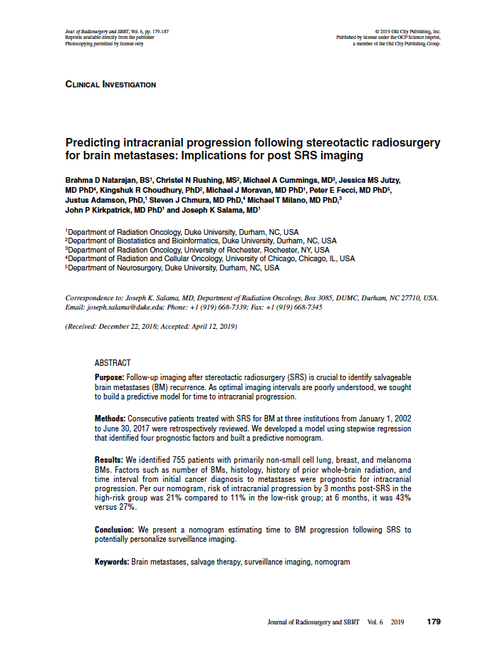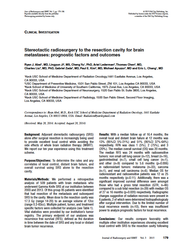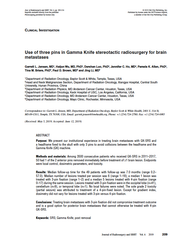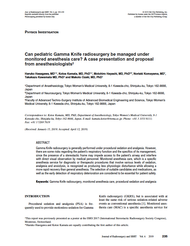- Home
- Journal Contents Downloads
- JRSBRT Downloads
- JRSBRT 6.3, p. 179-187
Product Description
Predicting intracranial progression following stereotactic radiosurgery for brain metastases: Implications for post SRS imaging
Brahma D. Natarajan, Christel N. Rushing, Michael A. Cummings, Jessica MS Jutzy, Kingshuk R. Choudhury, Michael J. Moravan, Peter E. Fecci, Justus Adamson, Steven J. Chmura, Michael T. Milano, John P. Kirkpatrick and Joseph K. Salama
Purpose: Follow-up imaging after stereotactic radiosurgery (SRS) is crucial to identify salvageable brain metastases (BM) recurrence. As optimal imaging intervals are poorly understood, we sought to build a predictive model for time to intracranial progression.
Methods: Consecutive patients treated with SRS for BM at three institutions from January 1, 2002 to June 30, 2017 were retrospectively reviewed. We developed a model using stepwise regression that identified four prognostic factors and built a predictive nomogram.
Results: We identified 755 patients with primarily non-small cell lung, breast, and melanoma BMs. Factors such as number of BMs, histology, history of prior whole-brain radiation, and time interval from initial cancer diagnosis to metastases were prognostic for intracranial progression. Per our nomogram, risk of intracranial progression by 3 months post-SRS in the high-risk group was 21% compared to 11% in the low-risk group; at 6 months, it was 43% versus 27%.
Conclusion: We present a nomogram estimating time to BM progression following SRS to potentially personalize surveillance imaging.
Keywords: Brain metastases, salvage therapy, surveillance imaging, nomogram
After payment has been processed for your order of a digital copy (PDF) of this article, you will see a download link on your completed order page and also receive an email containing a download link. The links, which will enable you to download one copy of the article, will expire after 24 hours.
 Loading... Please wait...
Loading... Please wait...








